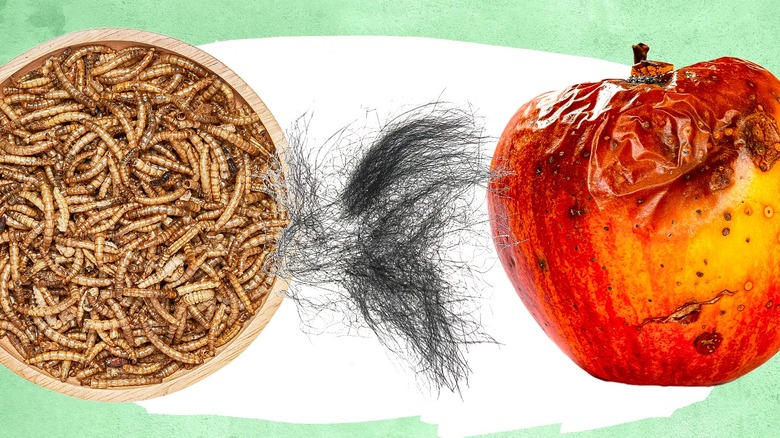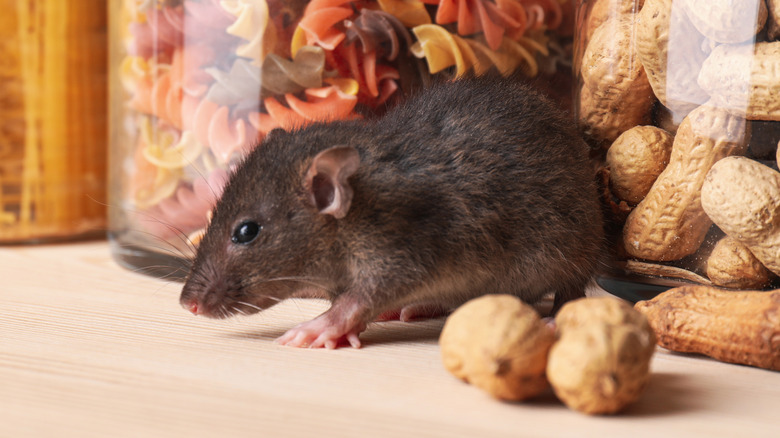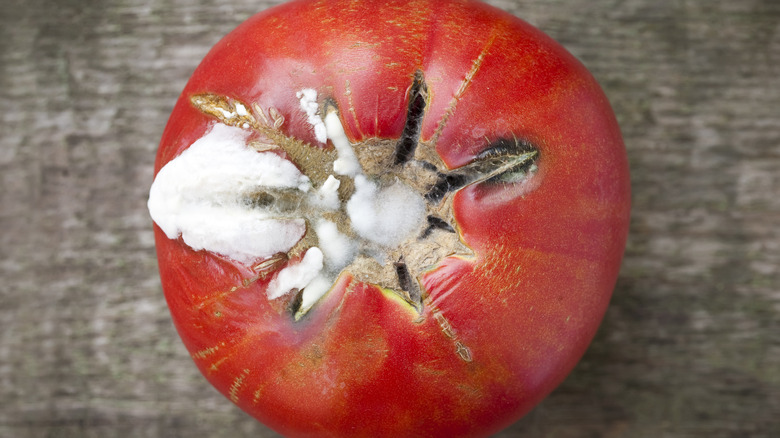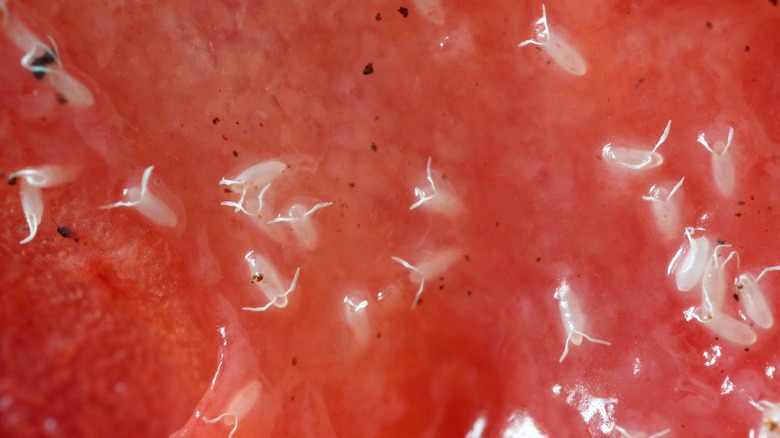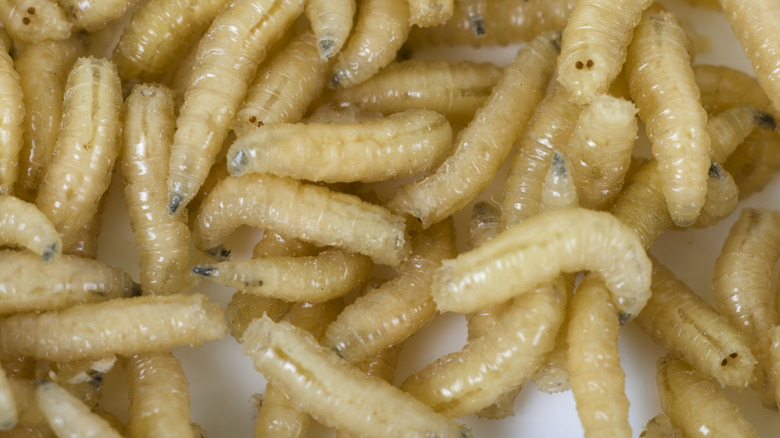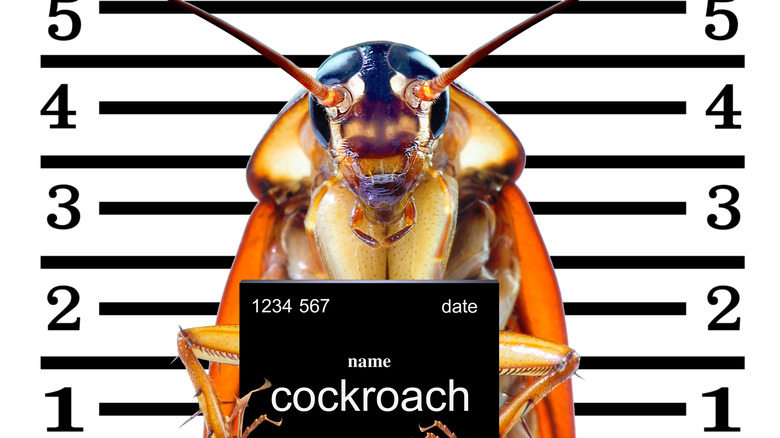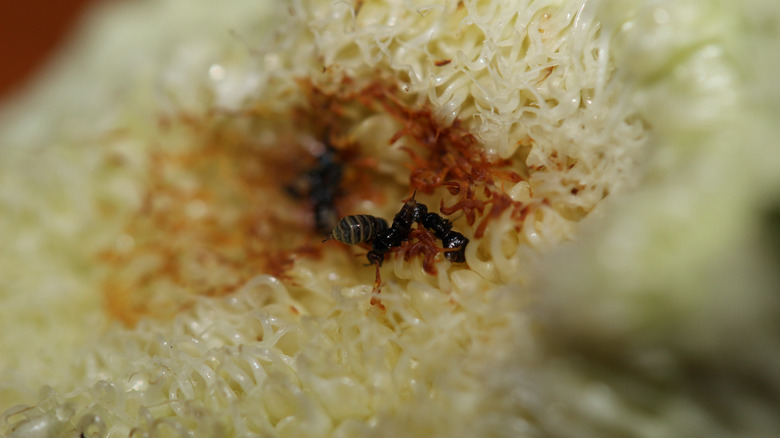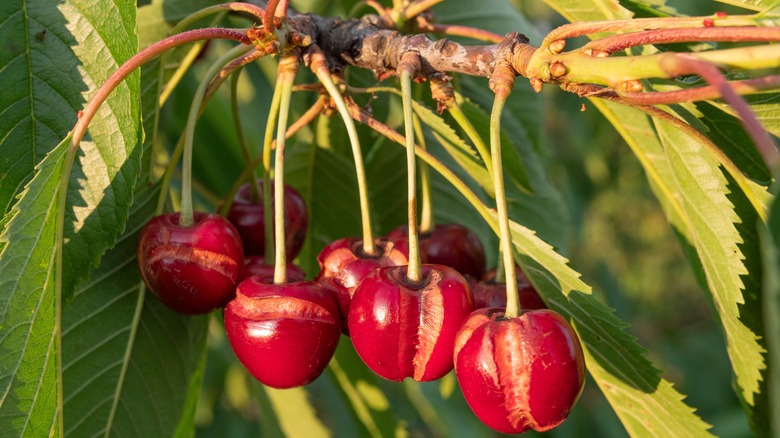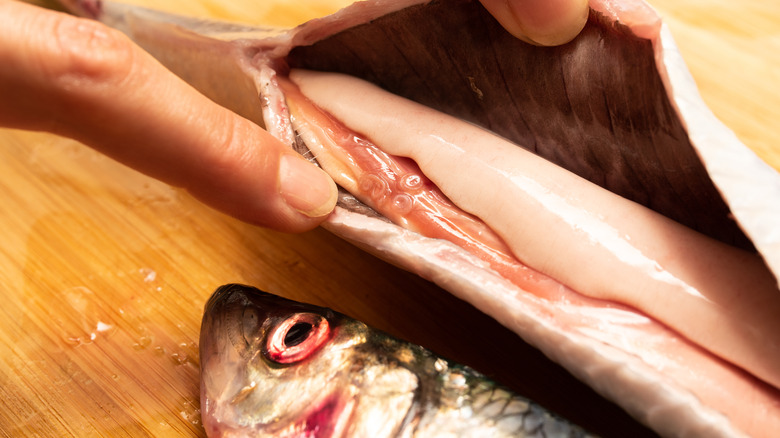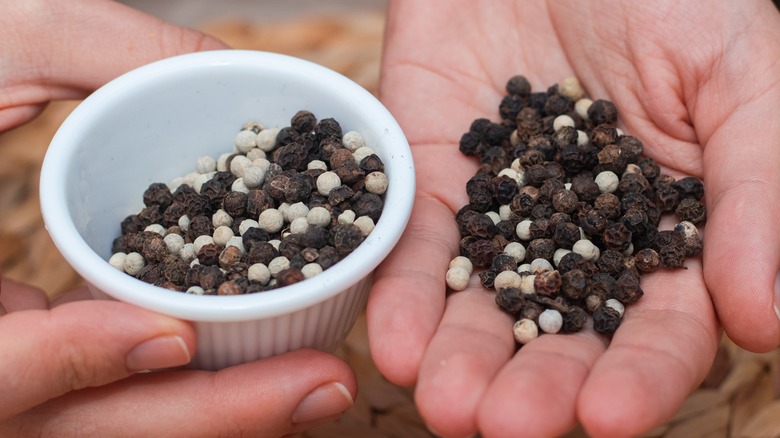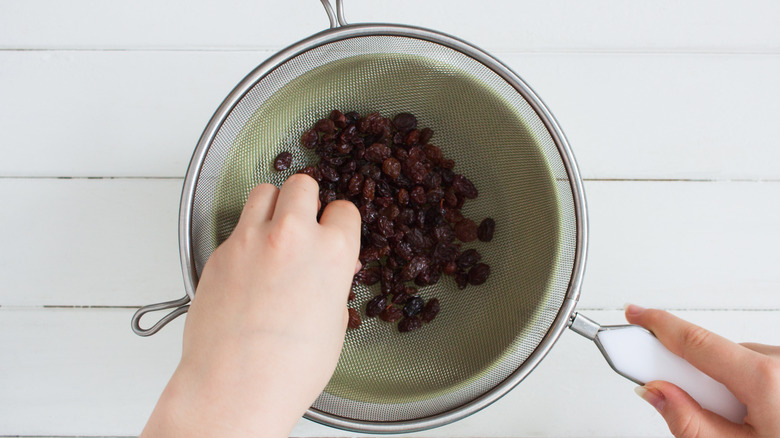11 Stomach-Turning Non-Food Items The FDA Allows In Our Food
Once you learn what non-food items the FDA allows in our foods, you'll never look at your meal the same way again. You may be unknowingly ingesting a lot of things you don't want to think about, as surprising ingredients show up in everything from fruit and vegetables to spices and raisins.
You can find the types of non-food items the FDA allows in its "Food Defect Levels Handbook," which provides a list of various foods and how many defects they can have before the agency takes action. In it, you'll find a list of allowable items you'd likely hope to never find in your food, like insects, animal waste, and foreign objects.
The FDA has created this guide because it's impossible to expect food from a farm or manufacturing facility to be perfect. Hungry animals and insects who are out foraging think they've hit the jackpot when they find such food caches, while food cleaning and sorting mistakes happen. These issues may not be visible if you're eating ground or processed food items, though the FDA has set limits on what's allowable. If you're curious about what your food might have hiding inside it, you'll want to read on. Just beware that it may cause you to lose your appetite.
1. Rodent hairs
Finding a hair in your food that belongs to a human is gross enough, but nobody wants to find rodent hairs in their food. Yet, the FDA has decided that it will allow it for all the times mice forget to put a hair net on when they're running through a food facility.
Rodent hair can simply be a piece of hair that has fallen off a rodent. However, since rodents also lick themselves and the hairs pass through their feces, it could be an indication that there's rodent feces in the food, too.
There are certain types of foods that are allowed to have rodent hairs in them with some types being more likely to contain those hairs than others. At the top of that list are ground herbs and spices; the FDA allows more rodent hairs in sage and oregano than any other food. In 10 grams of spice, ground sage is of concern when it has nine rodent hairs, while ground oregano becomes concerning with five rodent hairs. Other spices that are allowed to contain some level of rodent hair (in order of allowable hairs) include paprika, ground capsicum, cinnamon, marjoram, thyme, curry, allspice, nutmeg, and pepper. Some other foods that are allowed to have much smaller amounts include apple butter, cocoa powder, cornmeal, pasta, wheat flour, chocolate, peanut butter, and popcorn kernels.
2. Mold and mildew
The FDA allows a certain amount of mold and mildew in our food. Sometimes, the mold comes from machinery, or difficult-to-detect mold on rotting material may get ground into otherwise fresh product. Even though you may not be able to see mold or mildew growing on the surface of the food, a microscopic examination might reveal some.
Some foods are more dangerous to eat when moldy than others, as mycotoxins in mold can be dangerous enough to cause disease or even death. It's impossible to completely prevent mycotoxins from showing up in food, which is why the FDA has set upper safety limits to ensure that your exposure to them is minimal. Furthermore, eating a small amount of mold isn't bad in every case. Still, if you can see mold on your food without the help of a microscope, it should go straight into the trash.
More mold is allowed in black currant jam in currant jam than any other food product, only being deemed unsafe when the mold count hits 75%. Berries top out at 60% and strawberries at 45%. Meanwhile, canned tomatoes and tomato products like ketchup and pizza sauce become concerning in the 55% to 24% range. Cherry jam becomes unsafe at 30%, and salt-cured olives need action at 25%. Some other foods that are allowed lesser amounts of mold or mildew include apple butter, fruit juices, green coffee beans, canned greens, figs, peanuts, cocoa beans, canned and frozen peaches, and various spices.
3. Insect eggs
When insects have spent any amount of time on fresh or processed foods, they can leave behind insect eggs as tiny presents. Insects on food at any part of their life cycle is considered an infestation by the FDA.
There are several problems with insect eggs being on food. First, they may hatch and turn into larvae and then full-grown insects. Secondly, flies that use feces or rotten food for breeding can transfer bacteria like Salmonella or E. coli to their offspring and therefore your food. They can also spell intestinal myiasis, in which fly larvae survive digestion and go on to live in the human digestive tract.
The FDA allows insect eggs on some foods in small amounts. Tomato-based products are allowed more fly eggs than any other food, becoming concerning at 30 fly eggs per 100 grams of tomato paste or other tomato sauces like pizza sauce, 20 fly eggs per 100 grams of tomato puree, and 10 fly eggs on 500 grams of tomatoes or tomato juice. Golden raisins can have up to 35 fruit fly eggs per eight ounces before it's concerning. However, five or more fly eggs is the limit for citrus juice. The only other allowable type of insect egg in food is asparagus beetle eggs. You should find fewer than 10% of your asparagus spears infested with fewer than six beetle eggs or egg sacs.
4. Maggots and other insect larvae
Once insect eggs hatch, they become mobile and have an even greater chance of transmitting diseases to food. While insect eggs can be concerning, insects in their larval stages provide even more risk. One that's especially dreaded is maggots, which are fly larvae.
While flies can transmit diseases to their eggs, newly-mobile larvae can pick up some diseases on their own, too. If they feed on bacteria-infested food or feces before moving on to something you plan to eat, they can transmit those harmful bacteria. They can also potentially survive digestion and colonize your gastrointestinal tract in a condition known as intestinal myiasis. While some types of larvae can be safely turned into food, this definitely isn't part of that process.
Many of the FDA's rules about how many insect larvae or maggots are allowable depend on the size of the larvae or maggots. Often, fewer are allowed if they're extra large. A limited number of larvae are allowed on certain berries like blackberries and lingonberries as well as in canned and frozen peaches and spinach. A few corn ear worm or corn borer larvae are allowed on corn, and a small number of cowpea curculio larvae are allowed on black-eyed peas or cowpeas, while small amounts of maggots are allowable on cherries, tomato products, mushrooms, and citrus juice.
5. Whole insects, mites, and worms (dead or alive)
Your chances of finding whole insects, mites, and worms in your food are larger if you're consuming whole food that hasn't been ground. The FDA has even set rules regarding specific infesters like mites, scale insects, aphids, thrips, and worms.
At the high end of the spectrum, you'll find that the FDA isn't worried until there are 2,500 aphids in 10 grams of hops (about a third of an ounce). Hope you like insects with your beer. Many whole spices get suspicious when they're 1% to 5% infested; however, nutmeg isn't of official concern until it's 10% infested, while fennel seeds become alarming at 20% infested. Several types of canned and frozen veggies and fruits are allowed insects and worms. At the higher end, multer berries (cloudberries) raise the alarm at 40 or more thrips in a 20-ounce can, while frozen broccoli is concerning when it has 50 aphids, thrips, or mites in a 100-gram sample.
There are plenty of other categories of foods that are allowed insects, including cocoa and coffee beans, cornmeal, apple butter, dried fruits, and salt-cured olives. Nuts can be up to 5% or 10% infested depending on the type of nut and whether it is whole or shelled. And dead rather than live insects are what you're more likely to find in dates.
6. Insect fragments and heads
Like it or not, you may be consuming as many as 140,000 insect pieces each year. They show up more often in ground foods, though at least they potentially provide lots of nutrients, so you're coming out nutritionally ahead even if the idea turns your stomach.
The FDA allows insect fragments in some foods, including ground and processed spices; those that are allowed the most insect fragments are ground marjoram, oregano, and thyme. In 10 grams of spices, marjoram becomes concerning at 1,175 insect fragments, oregano at 1,250 fragments, and thyme at 925 fragments. You might want to start grinding your own spices if the idea of insect fragments bug you. Other products that are allowed to contain insect fragments include chocolate products, peanut butter, corn meal, wheat flour, macaroni, and other noodle products.
Meanwhile, the type of insect fragments allowed in fig paste is very specific, especially if you're vegan. Apparently, finding 12 insect heads in 100 grams of fig paste is no big deal. However, when you reach 13 heads, the FDA suggests action.
7. Rotting, rancid, and decomposing pieces of food
Nobody wants to find rotten food in what they buy, but it sometimes happens anyway. However, the FDA only makes allowances for a few types of food to contain rot, rancidity, or decomposition while in production. The source of most premature rot is bacteria, molds, or yeasts. Granted, some food may rot after the production as it's exposed to warmer temperatures, light, moisture, and microbes
There are a few fruits, veggies, and nuts that are allowed a small amount of rot or rancidity during production. Canned beets and plums need scrutiny if 5% or more are rotten, while fresh, canned, or frozen cherries need attention at 7%. Even potato chips are allowed a bit of rot, with action not necessary until 6% have gone over. Nuts and peanuts merit a closer look when 5% to 10% of them are rancid, depending on type and whether they're shelled or not. Sesame seeds and dried prunes need attention if 5% are decomposed. Canned eggs make the naughty list when two or more cans have decomposing eggs and two subsamples have 5 million bacteria per gram.
8. Shells and pits
Stray shells and pits sometimes make their way into food. However, the FDA doesn't let producers get too sloppy with it, as there are only a few foods where shells or pits are allowed.
As far as shells go, it's chocolate and nuts where the FDA allows small amounts. In the case of cacao nibs for chocolate liquor and cocoa powder, it's not a big deal to have a few shell fragments until the amount reaches 2%. Reject nuts are allowed to have a variety of problems including random empty shells. Depending on the type of nut and whether it's shelled or not, it becomes problematic when 5% or 10% are rejects.
Only a few pits or pit fragments are allowed in dates, olives, and prunes. In 900 grams of chopped, sliced, or macerated dates or in a sample of 100 pitted dates, there shouldn't be more than one very small pit or pit fragment. Luckily, date pits are safe when swallowed and are actually used as a caffeine-free coffee substitute in the Middle East.
In a sample of pitted olives or salad olives, less than 1.3% should have tiny pits or fragments. While olive pits aren't known to be toxic, they can break your teeth. Pits in prunes (dried plums) are more obviously worrisome, as they contain cyanide. They're safe if you swallow them whole, but poisonous if crushed. Nevertheless, the FDA doesn't balk until 2% of prunes have pits or pit fragments.
9. Parasites, parasitic cysts, and pus pockets
There are a few fish that the FDA allows to have parasites. When fish have parasites, they can leave behind a few disgusting-sounding malformities as well: cysts and pus pockets. Luckily, freezing fish can help to kill parasites, as can cooking fish up to 145 degrees Fahrenheit for at least 15 seconds.
Some types of fish are allowed to have a few parasitic cysts, like whitefish, chubs, inconnus, ciscoes, and tullibees. If 20% of these types of fish are infested with parasites, it's problematic if you can count 50 cysts in 100 pounds of fish. If 20% of fresh-water herring are infested with parasites, everything's fine and dandy until you find 60 cysts on 100 small fish or in 100 pounds of larger fish.
Red fish and ocean perch are allowed to have pus pockets, often caused when female copepod parasites burrow into the fish's skin. The FDA doesn't consider it problematic until 3% of the fish fillets contain a copepod and pus pocket.
10. Random foreign matter
Many of us have had the unfortunate experience of finding something in our food that didn't belong from sticks to small stones. It can even be something like a piece of machinery or cigarette butt that definitely has no business in our food. However, the FDA makes allowances for foreign matter in a few cases.
When the ground mace is sorted through a 20-mesh sieve, it becomes problematic when 1.5% of it contains foreign matter. Whole pepper is allowed even less, as it's considered defective if 1% of it contains trash (based on weight). Sesame seeds are subject to even stricter rules. If just 0.5% of the weight of sesame seeds comes from foreign matter, it is no longer acceptable. As for raisins, they can have up to four feathers in them per bin without it being problematic. Mmm, feathery raisins.
Luckily, it's in the best interest of food producers to prevent any foreign objects from ending up in your food. When people break their teeth on something or become sick from ingesting random objects that don't belong, they're well within their rights to sue.
11. Sand and grit
Your teeth probably have phantom pain just from thinking about crunching down on a piece of sand or grit, so the real stuff is hardly better. Obviously, sand ends up on our food sometimes; lettuce and other greens often have warnings on packages to remind you to wash them in case some sand is left behind. However, those aren't the products the FDA is concerned about when it comes to sand and grit content.
According to the FDA, both natural and golden raisins can have up to 40 milligrams of sand and grit in a 100-gram container. Inspectors actually put raisins in a sand shaker when they analyze them for defects. Luckily, there's no tolerance for embedded sand here, so you're not going to get that kind of surprise when you snack on raisins.
When it comes to cumin seeds, the FDA is more concerned with ash. Cumin seeds tend to be imports, with the most coming from India. While cumin seeds naturally contain ash, the fact that it's listed as a sand and grit issue for cumin and there's no fire involved in processing suggests that it comes from fertilizer. Cumin seeds can have up to 9.5% regular ash or 1.5% acid-insoluble ash mixed in before it's considered an issue.
